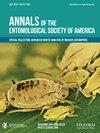Persistence of Two Salmonella enterica ser. Montevideo Strains Throughout Horn Fly (Diptera: Muscidae) Larval and Pupal Development
IF 3
3区 农林科学
Q1 ENTOMOLOGY
引用次数: 3
Abstract
Abstract Strains of Salmonella enterica can be subdivided into clades that differ in their genetic composition, influencing microbial ecology and bacterial transmission. Salmonella serovar Montevideo strains 1110 and 304, representatives of two different clades, were used to evaluate interactions with the various stages of horn fly development. Sterilized cattle dung was inoculated with Salmonella monocultures, and horn fly larvae were exposed to 103, 105, and 107 colony-forming units (CFU)/g per strain. Salmonella supported horn fly development, and concentration-dependent differences in pupal survival suggested that Salmonella Montevideo 304 impacts adult emergence when larvae are reared in a high concentration. Viable bacteria of each strain were quantified from larvae, pupae, and newly emerged adults. Both strains were cultured from larvae at a mean ~105, regardless of concentration, and both strains survived pupation. Quantities of Salmonella 1110 were stationary through the midpupal stage, after which quantities declined in pupae reared in 105 and increased twofold in pupae reared in 107 CFU/g. Quantities of Salmonella 304 remained stationary throughout pupal development when reared in 105, yet increased 29-fold when reared in 107 CFU/g. At high densities, properties of Salmonella 304 may influence its interaction with horn fly larvae, enabling the bacteria to evade degradation during larval gut histolysis and to subsequently proliferate during the late stages of pupal development. This may account for the observed effect on adult emergence. The Salmonella strains were rarely cultured from newly emerged adults, indicating that transstadial carriage to the adult stage is inefficient.两种肠道沙门氏菌的持续存在。整个角蝇(双翅目:蝇科)幼虫和蛹发育的蒙得维的亚菌株
摘要肠炎沙门氏菌菌株可细分为不同的遗传组成分支,影响微生物生态学和细菌传播。蒙得维的亚沙门氏菌血清型菌株1110和304是两个不同分支的代表,用于评估与角蝇发育不同阶段的相互作用。用单一培养的沙门氏菌接种灭菌牛粪,并将角蝇幼虫暴露于103、105和107菌落形成单位(CFU)/g每株。沙门氏菌支持角蝇的发育,蛹存活的浓度依赖性差异表明,当幼虫在高浓度下饲养时,蒙得维的亚304沙门氏菌会影响成虫的羽化。从幼虫、蛹和新出现的成虫中对每个菌株的活菌进行定量。无论浓度如何,这两种菌株都是从平均约105的幼虫中培养出来的,并且两种菌株均能化蛹。沙门氏菌1110的数量在蛹中期保持稳定,之后在105饲养的蛹中数量下降,在107CFU/g饲养的蛹中升高两倍。当以105培养时,沙门氏菌304的数量在整个蛹发育过程中保持不变,但当以107CFU/g培养时,数量增加了29倍。在高密度下,沙门氏菌304的特性可能影响其与角蝇幼虫的相互作用,使细菌能够在幼虫肠道组织溶解过程中逃避降解,并随后在蛹发育的后期增殖。这可能解释了观察到的对成虫羽化的影响。沙门氏菌菌株很少从新出现的成虫身上培养,这表明经尿道携带到成虫期是低效的。
本文章由计算机程序翻译,如有差异,请以英文原文为准。
求助全文
约1分钟内获得全文
求助全文
来源期刊
CiteScore
4.90
自引率
0.00%
发文量
25
审稿时长
6-12 weeks
期刊介绍:
The Annals of the Entomological Society of America exists to stimulate interdisciplinary dialogue across the entomological disciplines and to advance cooperative interaction among diverse groups of entomologists. It seeks to attract and publish cutting-edge research, reviews, collections of articles on a common topic of broad interest, and discussion of topics with national or international importance. We especially welcome articles covering developing areas of research, controversial issues or debate, and topics of importance to society. Manuscripts that are primarily reports of new species, methodology, pest management, or the biology of single species generally will be referred to other journals of the ESA. The most important criteria for acceptance are quality of work and breadth of interest to the readership.

 求助内容:
求助内容: 应助结果提醒方式:
应助结果提醒方式:


